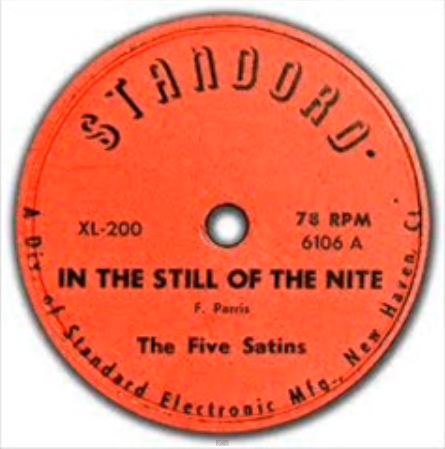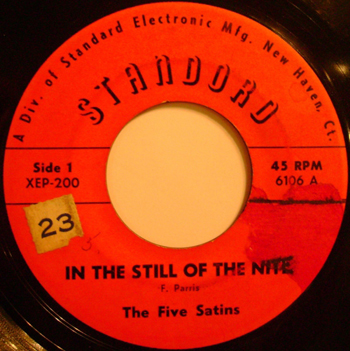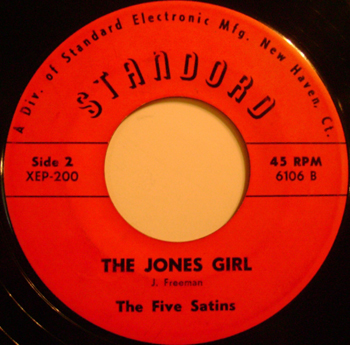
 |
| artist: | THE FIVE SATINS |
| label: | STANDORD RECORDS XEP-200, 6106 |
| release: | March 1956, USA, 10" 78rpm (also released on 7" 45rpm) |
| A-side: | In The Still Of The Nite (F. Parris) |
| B-side: | The Jones Girl (J. Freeman) |
| comment: | “In the Still of the Night” was originally released on Standard Records as the B-side to “The Jones Girl” in March 1956, but became a hit when reissued three months later on the Ember label. The Five Satins were formed in 1955 in New Haven, Connecticut by Fred Parris who had previously led the moderately successful group The Scarlets. The Scarlets had been formed in 1953 with Parris’ fellow Hillhouse High School students Sylvester Hopkins, Nathaniel Mosely, Jr., Albert Denby, and William L. Powers. After some minor hits, including Parris’ self-penned “Dear One,” the members were called up for national service and disbanded after cutting the farewell single “Kiss Me”. Parris was stationed in Philadelphia but would return to New Haven on weekends and was keen to continue making music. He formed the new group, The Five Satins, with members Lou Peebles, Stanley Dortch, Ed Martin and Jim Freeman. This line-up was shortlived, with Peebles and Dortch leaving and Al Denby of The Scarlets joining. The Five Satins were therefore temporarily only four and it was this line-up that recorded Parris’ romantic ballad “In the Still of the Night”.
One of the key features of “doo-wop” music is the use of nonsensical backing vocals, close vocal harmonies, and often the I – VI – IV – V chord progression. “In the Still of the Night” is a perfect example and it has in fact been speculated that the “Doo-wop doo-wah” backing vocals during the bridge of the song were responsible for this music genre later being called “doo-wop”. While it is probably the most high profile song to include the “doo-wop” vocalisation, it certainly wasn’t the first. “Doo-wop” appears in tracks such as The Clovers’ “Good Lovin’” (1953), Carlyle Dundee & The Dundees’ “Never” (1954), and The Turbans’ “When You Dance” (1955). As influential as the “Doo-wop doo-wah” vocals might have been, the similarly nonsensical “Sha-doo shooby-doo” backing vocals that introduce the song and are repeated throughout the verses are a more dominant feature of the song and key to its success. To understand why that is the case, you need to hear the song. It just wouldn’t be the same without it. “In the Still of the Night” is ranked at number 90 on Rolling Stone’s list of the “500 Greatest Songs of All Time”. Rolling Stone correctly noted that this is far from a perfect recording from a technical standpoint, which is hardly surprising given the makeshift recording conditions. There’s the crack of the sax during the instrumental, occasional pitch issues, and muffled piano and drums. None of that matters a jot of course because, as noted by Rolling Stone, despite these imperfections the song is “a sublime piece of doo-wop”. “In the Still of the Night” found a new audience in 1987 when it featured on the soundtrack of the hugely successful “Dirty Dancing” movie (and in one of the most important romantic scenes). |
| comment #2: | The song was recorded in the Saint Bernadette Catholic School basement in New Haven, Connecticut, in February, 1956. Marty Kugell produced the song. The saxophone solo was played by Vinny Mazzetta, of New Haven.The rhythm section was Doug Murray, bass, Bobby Mapp, drums and Curlee Glover, piano. It was originally released as a B-side (to "The Jones Girl", a play on the Mills Brothers' 1954 hit, "The Jones Boy") on Kugell's Standard Records label. Although the single was only a moderate hit (after it was reissued on the Ember label), peaking at #24 on the national pop charts and #3 on the R&B "race" charts (Billboard's chart designation for R&B during that time), its reputation came to surpass its original chart placement. For three decades, the single almost always topped the influential Top 500 Songs countdown on oldies radio station WCBS-FM. The track sold over 10 million copies in 1987 and 1988 as part of the Dirty Dancing soundtrack. It is ranked #90 on the Rolling Stone magazine's list of "the 500 Greatest Songs of All Time". (The song was included on the highly influential 1959 LP Oldies But Goodies on Original Sound.) "In the Still of the Night" is the only song to have charted on the Billboard Hot 100 three separate times, by the same artist with the same version each time. After initially reaching #24 in 1956, it was released again in 1960 and reached #81. Then more than a year later in 1961 it reached #99. "In the Still of the Night" is one of two songs that may lay claim to being the origin of the term doo-wop. The plaintive doo wop, doo wah refrain in the bridge has often been suggested as the origin of the term to describe that musical genre. (The other contender for the honor is "When You Dance" by The Turbans, in which the chant "doo-wop" can be heard.) |
| signed sheet music: |
|
  |
this is the 45rpm release |